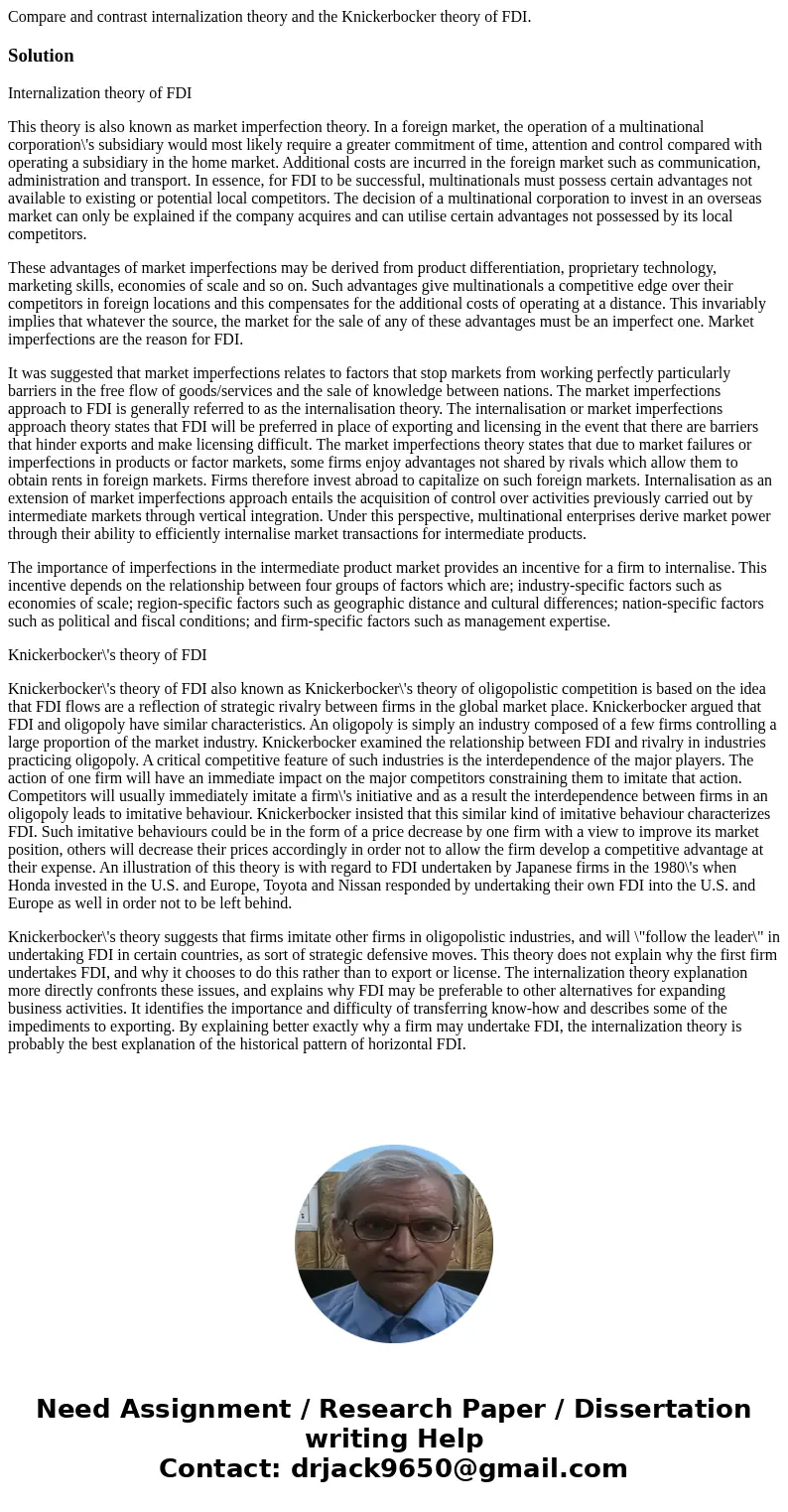Compare and contrast internalization theory and the Knickerb
Compare and contrast internalization theory and the Knickerbocker theory of FDI.
Solution
Internalization theory of FDI
This theory is also known as market imperfection theory. In a foreign market, the operation of a multinational corporation\'s subsidiary would most likely require a greater commitment of time, attention and control compared with operating a subsidiary in the home market. Additional costs are incurred in the foreign market such as communication, administration and transport. In essence, for FDI to be successful, multinationals must possess certain advantages not available to existing or potential local competitors. The decision of a multinational corporation to invest in an overseas market can only be explained if the company acquires and can utilise certain advantages not possessed by its local competitors.
These advantages of market imperfections may be derived from product differentiation, proprietary technology, marketing skills, economies of scale and so on. Such advantages give multinationals a competitive edge over their competitors in foreign locations and this compensates for the additional costs of operating at a distance. This invariably implies that whatever the source, the market for the sale of any of these advantages must be an imperfect one. Market imperfections are the reason for FDI.
It was suggested that market imperfections relates to factors that stop markets from working perfectly particularly barriers in the free flow of goods/services and the sale of knowledge between nations. The market imperfections approach to FDI is generally referred to as the internalisation theory. The internalisation or market imperfections approach theory states that FDI will be preferred in place of exporting and licensing in the event that there are barriers that hinder exports and make licensing difficult. The market imperfections theory states that due to market failures or imperfections in products or factor markets, some firms enjoy advantages not shared by rivals which allow them to obtain rents in foreign markets. Firms therefore invest abroad to capitalize on such foreign markets. Internalisation as an extension of market imperfections approach entails the acquisition of control over activities previously carried out by intermediate markets through vertical integration. Under this perspective, multinational enterprises derive market power through their ability to efficiently internalise market transactions for intermediate products.
The importance of imperfections in the intermediate product market provides an incentive for a firm to internalise. This incentive depends on the relationship between four groups of factors which are; industry-specific factors such as economies of scale; region-specific factors such as geographic distance and cultural differences; nation-specific factors such as political and fiscal conditions; and firm-specific factors such as management expertise.
Knickerbocker\'s theory of FDI
Knickerbocker\'s theory of FDI also known as Knickerbocker\'s theory of oligopolistic competition is based on the idea that FDI flows are a reflection of strategic rivalry between firms in the global market place. Knickerbocker argued that FDI and oligopoly have similar characteristics. An oligopoly is simply an industry composed of a few firms controlling a large proportion of the market industry. Knickerbocker examined the relationship between FDI and rivalry in industries practicing oligopoly. A critical competitive feature of such industries is the interdependence of the major players. The action of one firm will have an immediate impact on the major competitors constraining them to imitate that action. Competitors will usually immediately imitate a firm\'s initiative and as a result the interdependence between firms in an oligopoly leads to imitative behaviour. Knickerbocker insisted that this similar kind of imitative behaviour characterizes FDI. Such imitative behaviours could be in the form of a price decrease by one firm with a view to improve its market position, others will decrease their prices accordingly in order not to allow the firm develop a competitive advantage at their expense. An illustration of this theory is with regard to FDI undertaken by Japanese firms in the 1980\'s when Honda invested in the U.S. and Europe, Toyota and Nissan responded by undertaking their own FDI into the U.S. and Europe as well in order not to be left behind.
Knickerbocker\'s theory suggests that firms imitate other firms in oligopolistic industries, and will \"follow the leader\" in undertaking FDI in certain countries, as sort of strategic defensive moves. This theory does not explain why the first firm undertakes FDI, and why it chooses to do this rather than to export or license. The internalization theory explanation more directly confronts these issues, and explains why FDI may be preferable to other alternatives for expanding business activities. It identifies the importance and difficulty of transferring know-how and describes some of the impediments to exporting. By explaining better exactly why a firm may undertake FDI, the internalization theory is probably the best explanation of the historical pattern of horizontal FDI.

 Homework Sourse
Homework Sourse